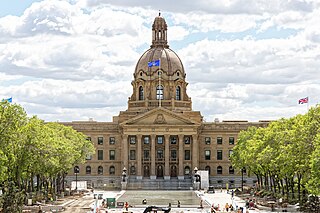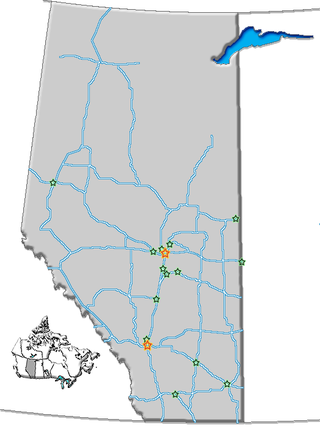
Fort Calgary was a North-West Mounted Police outpost at the confluence of the Bow and Elbow rivers in present-day Calgary, Alberta, Canada. Originally named Fort Brisebois, after the outpost's first commander, the outpost was renamed Fort Calgary in June 1876.

The Reynolds-Alberta Museum is an agricultural, industrial, and transportation museum in Wetaskiwin, Alberta, Canada. The museum is situated on an 89-hectare (220-acre) property containing the main museum building, an aviation display hangar, and its storage facility.

The Fairmont Hotel Macdonald, formerly and commonly known as the Hotel Macdonald, is a large historic luxury hotel in Edmonton, Alberta, Canada. Located along 100 Street NW, south of Jasper Avenue, the hotel is situated in the eastern end of downtown Edmonton, and overlooks the North Saskatchewan River. The 47.7-metre-high (156 ft) hotel building was designed by Ross and MacFarlene and contains eleven floors. The hotel is named for the first prime minister of Canada, Sir John A. Macdonald.

Fort Edmonton Park is an attraction in Edmonton, Alberta, Canada. Named for the first enduring European post in the area of modern-day Edmonton, the park is the largest living history museum in Canada by area. It includes both original and rebuilt historical structures representing the history of Edmonton, and is staffed during the summer by costumed historical interpreters.

The Art Gallery of Alberta (AGA) is an art museum in Edmonton, Alberta, Canada. The museum occupies an 8,000 square metres (86,000 sq ft) building at Churchill Square in downtown Edmonton. The museum building was originally designed by Donald G. Bittorf, and B. James Wensley, although portions of that structure were demolished or built over during a redevelopment of the building by Randall Stout.

The Fairmont Jasper Park Lodge, formerly and commonly known as Jasper Park Lodge, is a 442-room hotel on a 2.8 km2 (700-acre) site along Lac Beauvert in Jasper National Park, Alberta, Canada. The hotel was established in 1921 by Canadian National Railway and is one of Canada's grand railway hotels.

The Alberta Legislature Building is in Edmonton and is the meeting place of the Legislative Assembly of Alberta and the Executive Council of Alberta. It is often shortened to "the Ledge".

Alberta has been a tourist destination since the early days of the 20th Century, with attractions including national parks, National Historic Sites of Canada, urban arts and cultural facilities, outdoor locales for skiing, hiking and camping, shopping locales such as West Edmonton Mall, outdoor festivals, professional athletic events, international sporting competitions such as the Commonwealth Games and Olympic Winter Games, as well as more eclectic attractions.

Downtown Edmonton is the central business district of Edmonton, Alberta. Located at the geographical centre of the city, the downtown area is bounded by 109 Street to the west, 105 Avenue to the north, 97 Street to the east, 97 Avenue and Rossdale Road to the south, and the North Saskatchewan River to the southeast.

Boyle Street is a neighbourhood located in central Edmonton, Alberta, Canada, immediately east of the downtown core. The neighbourhood is bounded by Grierson Hill to Rowland Road until Alex Taylor Road and then Jasper Avenue east until 82 Street by the south, 82 Street by the east, 97 Street by the west, and the LRT tracks to the north, with Jasper Avenue and 103A Avenue running through the neighbourhood.

Provincial historic sites of Alberta are museums and historic sites run by the Government of Alberta.

The Edmonton Convention Centre, is a meeting, entertainment, and convention venue located in Edmonton, Alberta, Canada. Opened in 1983, it is managed by Explore Edmonton, the destination marketing organization of the city of Edmonton.

Jasper Avenue is an arterial road in central Edmonton, Alberta, and is the city's main street. Jasper Avenue has no official street number but is aligned with 101 Avenue with the majority of its length. Jasper Avenue is a major public transit route as several of Edmonton's busiest bus routes travel along it. The LRT travels underneath Jasper Avenue between 99 and 110 Streets. It is named after Jasper Hawes, manager of a North West Company trading post of Jasper House in the early 1800s, located in present-day Jasper National Park.
Stony Plain Road is an expressway and arterial road Edmonton, Alberta. Parkland Highway is an alternative route to the corresponding section of Highway 16 in Parkland County.

South Edmonton station, known as Strathcona station prior to 1932, was built by the Calgary and Edmonton Railway in what was then the City of Strathcona, Alberta. Construction on the station was started in 1907, completed in 1908, and expanded in 1910.
The Alberta Association of Architects published their Chronicle of Significant Alberta Architecture in February 2003 and August 2005. The project's main goal was to ensure that the public, as well as those with a professional interest in the subject, could easily identify architecturally significant structures developed and still standing in Alberta. The project was undertaken in association with the Government of Alberta.

The Princess Theatre is a two-screen art-house cinema located at 10337 Whyte Avenue in Edmonton's historic Old Strathcona neighbourhood. The building was designed by prominent Edmonton architects Wilson and Herrald, a firm responsible for the design of many other Edmonton heritage sites. It became Edmonton's oldest surviving theatre after the demolition of the Gem Theatre in 2006. The building currently houses the main 400-seat theatre as well as the 100-seat Princess II, located in the basement.

McKay Avenue School is a former school and historic site in Edmonton, Alberta, Canada. The site is a Provincial and Municipal Historic Resource, and home to the Edmonton Public School Board's archives and museum.



















